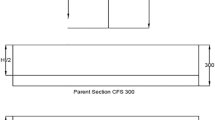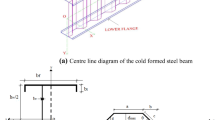Abstract
This paper presents a numerical simulation and experimental investigation on the static behavior of cold-formed steel beams with trapezoidally corrugated web has been carried out to find its structural performance of simply supported beam under pure bending. The steel beams with corrugated steel webs represent a new innovative which has emerged in the past decade for short- and medium-span beams. The thin corrugated web affords a significant weight reduction of these beams, compared with hot-rolled beams. In the initial solution, the flanges are made of flat plates, welded to the trapezoidal web sheet, requiring a specific welding technology. The connecting between flanges to the web can be done by means of intermittent welding. The paper summarizes the experimental and numerical investigations carried out at the Hindustan University and, at the end, presents the flexural behavior of cold-formed steel beams with trapezoidally corrugated web. To find the effect of web corrugation, 12 experiments were conducted on cold-formed steel beams. Beams having two different web depth-thickness (dw/tw) ratio 60 and 80 and with three types of web corrugation angles 0°, 30° and 45° were tested. Two beams were tested in each series. The static performance of the three different corrugation angles, including failure mode, load–deflection curves, strength capacity, load–strain curves, moment–curvature curves, flexural stiffness and ductility, are compared and discussed in detail based on the experimental results. Finally, numerical analysis using ANSYS Workbench results are analyzed and the experimental results were validated with the results obtained from the finite element analysis.


















Similar content being viewed by others
References
Abbas, H. H., & Driver, R. G. (2007). Simplified analysis of flange transverse bending of corrugated web girders under in-plane moment and shear. Engineering Structures, 29, 2816–2824.
Abbas, H. H., Sause, R., & Driver, R. G. (2006). Behavior of corrugated web Igirders under in- plane loading. Journal of Structural Engineering, ASCE, 132(8), 806–814.
Abbas, H., Sause, R., & Driver, R. G. (2007). Analysis of flange transverse bending of corrugated web I-girders under in-plane loads. Journal of Structural Engineering, 133(3), 347–355.
Chan, C. L., Khalid, Y. A., Sahari, B. B., & Hamouda, A. M. S. (2002). Finite element analysis of corrugated web beams under bending. Journal of Constructional Steel Research, 58, 1391–1406.
Divahar, R., & Joanna, P. S. (2014). The effect of web corrugation in cold- formed steel beam with trapezoidally corrugated web. American Journal of Engineering Research, 5(3), 137–142.
Driver, R. G., Abbas, H. H., & Sause, R. (2006). Shear behavior of corrugated web bridge girders. Journal of Structural Engineering, 132(2), 195–203.
Elgaaly, M., & Seshadri, A. (1998). Depicting the behavior of girders with corrugated webs up to failure using non-linear finite element analysis. Advances in Engineering Software, 29(3–6), 195–208.
He, J., Liu, Y., Lin, Z., Chen, A., & Yoda, T. (2012). Shear behavior of partially encased composite I-girder with corrugated steel web: Numerical study. Journal of Constructional Steel Research, 70, 166–182.
Ibrahim, S. A., EI-Dakhakhni, W. W., & Elgaaly, M. (2006). Behavior of bridge girders with corrugated webs under monotonic and cyclic loading. Engineering Structures, 28, 1941–1955.
Khalid, Y. A., Chan, C. L., & Sahari, B. B. (2004). Bending behaviour of corrugated web beams. Journal of Materials Processing Technology, 150, 242–254.
Luo, R., & Edlund, B. (1996). Shear capacity of plate girders with trapezoidally corrugated webs. Thin-Walled Structures, 26(1), 19–44.
Manju, T., Arundhavapriya, E., & Bharath, S. K. B. (2016). Study on behavior of corrugated webs in cold formed steel sections with varying thickness. Asian Journal of Civil Engineering, 7, 1025–1033.
Sayed-Ahmed E. Y. (2005). Lateral torsion-flexure buckling of corrugated web steel girders. Proceedings of the Institution of Civil Engineers Structures & Buildings, pp. 53–69.
Usman, F. (2014). Shear resistance of trapezoidal corrugated web in local buckling. Applied Mechanics and Materials, 554, 421–425.
Author information
Authors and Affiliations
Corresponding author
Rights and permissions
About this article
Cite this article
Divahar, R., Joanna, P.S. Numerical simulation and experimental investigation on static behavior of cold formed steel beam with trapezoidally corrugated web by varying depth-thickness ratio. Asian J Civ Eng 19, 121–137 (2018). https://doi.org/10.1007/s42107-018-0012-9
Received:
Accepted:
Published:
Issue Date:
DOI: https://doi.org/10.1007/s42107-018-0012-9




